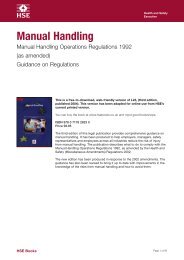Making Companies Safe - what works? (CCA ... - Unite the Union
Making Companies Safe - what works? (CCA ... - Unite the Union
Making Companies Safe - what works? (CCA ... - Unite the Union
You also want an ePaper? Increase the reach of your titles
YUMPU automatically turns print PDFs into web optimized ePapers that Google loves.
Whilst appearing to offer advantages in terms of a more efficient use of inspection resources,<br />
such an approach would also be consistent with <strong>the</strong> current Government’s commitment<br />
to lighten <strong>the</strong> burdens on business through ‘targeted deregulation’. 9 It appears that<br />
HSC/E are now seriously considering this possibility, and have recently published an internal<br />
discussion document in which <strong>the</strong>y suggest how certain employers might be exempted from<br />
routine inspection. The HSE describe such an approach as ‘earned autonomy’:<br />
“meaning that <strong>the</strong> performance and standards of a particular duty holder<br />
are good enough to earn <strong>the</strong>m autonomy from routine intervention by <strong>the</strong><br />
regulator.”<br />
The paper notes that:<br />
“An approach on similar lines has been operated by OSHA in <strong>the</strong> US for <strong>the</strong> last 20<br />
years in <strong>the</strong>ir ‘Voluntary Protection Programme’”. 10<br />
Only certain companies would be offered <strong>the</strong> chance to participate in this scheme, but how<br />
would <strong>the</strong>se organisations be selected? HSE has suggested that such duty holders might be<br />
expected to possess some of <strong>the</strong> following:<br />
1. An internal health and safety management system conforming to some standard and<br />
subject to regular internal or third-party auditing that would be paid for by <strong>the</strong><br />
organisation.<br />
2. ‘Good’ 11 performance in relation to a specified measure such as injury rates.<br />
3. Effective systems for employee involvement.<br />
4. Involvement of directors by making a named main board director (or equivalent)<br />
responsible for health and safety.<br />
5. Effective systems for engaging with third parties. 12<br />
A number of assumptions underlie <strong>the</strong>se proposals. First, we must assume that <strong>the</strong>re are<br />
indeed some organisations that have already achieved, or are capable of achieving, effective<br />
internal self-regulation through systematic management of OHS and that this will continue<br />
in <strong>the</strong> absence of routine regulatory inspection and intervention. Second, since it is<br />
acknowledged that <strong>the</strong>re will be some enterprises that lack a genuine commitment to OHS<br />
but will attempt to gain <strong>the</strong> administrative or public relations benefits of earned autonomy by<br />
adopting ‘paper systems’, 13 we must assume ei<strong>the</strong>r that <strong>the</strong> selection criteria HSE uses will<br />
‘screen out’ such companies, or that third party oversight will provide a reliable mechanism<br />
for identifying ‘paper compliance’ once companies have been granted earned autonomy<br />
status. And third, we must assume that adoption of ‘earned autonomy’ will indeed allow<br />
for more effective use of <strong>the</strong> inspectorate’s resources.<br />
In <strong>the</strong> following sections we will consider to <strong>what</strong> extent <strong>the</strong> empirical evidence supports<br />
<strong>the</strong>se assumptions.<br />
OSHA’s Voluntary Protection and Cooperative<br />
Compliance Programs<br />
Gunningham and Johnstone state that: “an example of how self-regulation can be made<br />
to work in practice is that of <strong>the</strong> Voluntary Protection Program” 14 (VPP). OHSA’s Voluntary<br />
Protection Program began in 1982 and was offered to companies considered to have<br />
exemplary health and safety records and which agreed to abide by certain conditions –<br />
including <strong>the</strong> adoption of a systems-based approach to OHS management. 15 The schemes rely<br />
on various incentives to encourage <strong>the</strong> participation of ‘good performers’, including <strong>the</strong><br />
awarding of stars and logos to participating companies and exemption from routine OSHA<br />
inspections. 16 As of 1999, <strong>the</strong> VPP program included 516 companies, employing more than<br />
300,000 workers. 17<br />
84
















